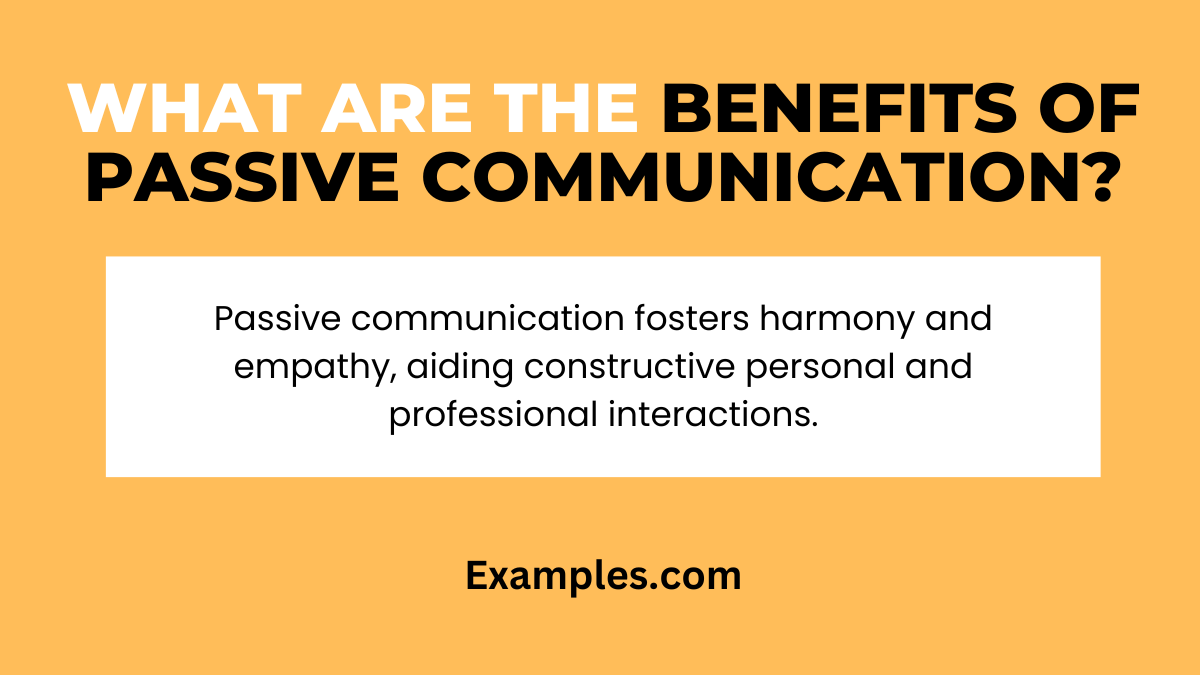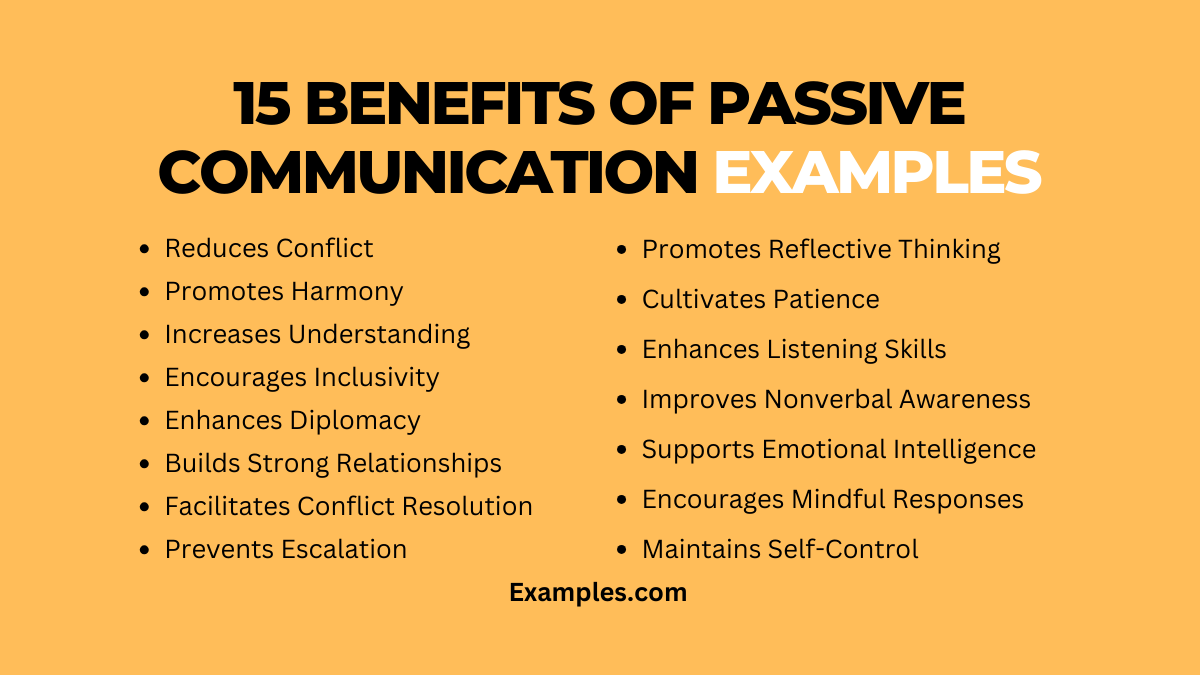Benefits of Passive Communication
In this guide, we explore the numerous benefits of Passive Communication, showcasing its significant impact in both personal and professional contexts. Integrating the Passive element in communication is not about silence; rather, it’s about expressing oneself in a non-confrontational, thoughtful manner. This approach enhances Effective Communication, fosters better Interpersonal Relationships, and reduces Miscommunication. Through real-life examples and practical tips, this guide will illustrate how passive communication can be a powerful tool for navigating complex social dynamics, making it an essential skill in today’s diverse communication landscape.
What are the Benefits of Passive Communication?

The benefits of Passive Communication encompass a range of positive outcomes achieved through a communication style that emphasizes indirectness, non-confrontation, and subtlety. This approach is characterized by a preference for listening over speaking, the avoidance of direct conflict, and the use of gentle language and nonverbal cues. Passive Communication is particularly effective in maintaining harmony, reducing the likelihood of misunderstandings and conflicts. It plays a crucial role in fostering environments where empathy, understanding, and mutual respect are prioritized. This communication style is beneficial in both personal and professional contexts, aiding in the navigation of diverse social dynamics and promoting more peaceful and constructive interactions.
15 Benefits of Passive Communication Examples

- Reduces Conflict: Passive communication helps avoid unnecessary conflicts by expressing opinions gently.
Example: “I see your point, and I also think we might consider some alternatives.” - Promotes Harmony: It encourages a peaceful and cooperative environment, especially important in team settings.
Example: “I’m happy to go with the team’s decision on this matter.” - Increases Understanding: By listening more and speaking less, passive communication fosters deeper understanding.
Example: “I’d like to understand your perspective better. Could you tell me more about it?” - Encourages Inclusivity: This approach ensures all voices are heard, especially in diverse groups.
Example: “Let’s make sure everyone has a chance to share their thoughts.” - Enhances Diplomacy: It’s effective in delicate situations where tact is required.
Example: “Perhaps there’s a way we can address this that meets everyone’s needs.” - Builds Strong Relationships: Passive communication often leads to stronger, more empathetic relationships.
Example: “I value your input and would love to hear your thoughts on this.” - Facilitates Conflict Resolution: It’s instrumental in resolving disagreements amicably.
Example: “I understand where you’re coming from. Let’s find a solution that works for both of us.” - Prevents Escalation: Keeping a calm demeanor prevents situations from escalating.
Example: “I think we’re both a bit upset. Maybe we should discuss this later?” - Promotes Reflective Thinking: Encourages thoughtful consideration before responding.
Example: “Let me take some time to think about this before I respond.” - Cultivates Patience: It teaches the value of patience in communication.
Example: “I appreciate your eagerness, but let’s consider this carefully.” - Enhances Listening Skills: Focuses on listening to understand, not just to respond.
Example: “I’m listening. Please continue, I want to understand your viewpoint fully.” - Improves Nonverbal Awareness: Heightens sensitivity to nonverbal cues in communication.
Example: Noticing a colleague’s hesitation and asking, “Do you have some concerns about this?” - Supports Emotional Intelligence: Helps in recognizing and respecting others’ emotions.
Example: “I can see this is important to you. Let’s talk about why that is.” - Encourages Mindful Responses: Promotes thoughtful and considered responses.
Example: “I need to reflect on this a bit more before giving my opinion.” - Maintains Self-Control: Helps in maintaining composure in challenging situations.
Example: “I’m feeling a bit overwhelmed. Let’s pause and revisit this discussion later.”
Benefits of Passive Communication in Business

- Fosters a Supportive Atmosphere: Passive communication creates a more supportive and less competitive atmosphere.
Example: “Your idea seems interesting, let’s explore it together for the project.” - Enhances Customer Relations: It helps in handling customer queries and complaints more effectively and empathetically.
Example: “I understand your concern, let’s see how we can resolve this for you.” - Facilitates Better Team Dynamics: Encourages team members to express their views in a non-threatening way.
Example: “I think everyone’s input could be valuable for this decision.” - Prevents Misunderstandings: Aids in clarifying instructions or objectives without coming across as overbearing.
Example: “Could you please elaborate on this point for better clarity?” - Encourages Thoughtful Decision-Making: Promotes taking time to consider all aspects before making decisions.
Example: “Let’s weigh all options before finalizing our strategy.” - Builds Long-term Client Relationships: Passive communication helps in nurturing trust and loyalty with clients.
Example: “We value your feedback and are committed to working together for long-term success.” - Reduces Workplace Stress: Leads to a less aggressive and more relaxed work environment.
Example: “Let’s approach this challenge calmly and find a solution together.” - Improves Interdepartmental Communication: Helps in smoothing over potential conflicts between different departments.
Example: “I believe both teams have valid points, let’s find a middle ground.” - Facilitates Change Management: Assists in gently introducing and managing changes within the organization.
Example: “How do you feel about these changes, and what are your thoughts on them?” - Enhances Leadership Approachability: Makes leaders more approachable and open to feedback.
Example: “I’m here to listen to any concerns or suggestions you might have.”
How can Passive Communication Benefit Personal Relationships?
- Enhances Emotional Connection: Passive communication encourages listening with empathy, a key aspect of Effective Communication. This attentiveness to a partner’s feelings and needs fosters a deeper emotional connection.
- Promotes Mutual Respect: By prioritizing understanding over rebuttal, passive communication in relationships underscores respect. It shows a commitment to valuing the other person’s viewpoint, critical in maintaining healthy Interpersonal Communication.
- Reduces Confrontations: Adopting a passive approach helps in addressing potentially contentious issues gently, reducing the chances of escalations. This is particularly beneficial in maintaining harmony in close relationships.
- Builds Trust and Safety: Consistently using passive communication creates a safe environment where each person feels heard and understood, essential elements in building trust within any relationship.
- Facilitates Compromise: In situations requiring negotiation or compromise, such as family decision-making, passive communication can pave the way for solutions that are agreeable to all parties, demonstrating the utility of Good Communication Skills.
What are the Benefits of Passive Communication in Multicultural Environments?

- Promotes Cultural Sensitivity: Passive communication is key in demonstrating respect for different cultural perspectives. It allows for the expression of ideas in a way that is sensitive to diverse cultural norms, crucial in Cross Cultural Communication.
- Encourages Inclusiveness: By allowing room for multiple voices to be heard, passive communication ensures that no single perspective dominates the conversation. This inclusiveness is vital in environments where Intercultural Communication is necessary.
- Reduces Misunderstandings: In settings where language barriers might exist, passive communication minimizes the risk of misunderstandings. It provides a platform for clear, unhurried dialogue, essential in Multicultural Communication.
- Facilitates Team Cohesion: In diverse teams, passive communication helps in forming a cohesive unit by ensuring that all members, regardless of their cultural background, feel valued and heard.
- Enhances Global Business Relations: For businesses operating in a global context, adopting passive communication can significantly improve relations with international partners, emphasizing the importance of Global Communication Challenges and Business Communication.
This comprehensive guide on the Benefits of Passive Communication illustrates how this subtle yet powerful communication style can positively impact various aspects of life. From enhancing personal relationships to facilitating smoother interactions in multicultural and business environments, passive communication proves to be an invaluable skill, promoting empathy, understanding, and harmony in diverse settings.



